Featured Articles
BOOK EXCERPT: “Jack Johnson, Rebel Sojourner”
 Jack Johnson—born in Texas, the son of former slaves—was the most famous black man on the planet. As the first African American World Heavyweight Champion (1908–1915), he publicly challenged white supremacy at home and abroad, enjoying the same audacious lifestyle of conspicuous consumption, masculine bravado, and interracial love wherever he traveled. Jack Johnson, Rebel Sojourner provides the first in-depth exploration of Johnson’s battles against the color line in places as far-flung as Sydney, London, Cape Town, Paris, Havana, and Mexico City. In relating this dramatic story, Theresa Runstedtler, author of “Jack Johnson, Rebel Sojourner,” constructs a global history of race, gender, and empire in the early twentieth century. Here is an excerpt from the first chapter of the book.
Jack Johnson—born in Texas, the son of former slaves—was the most famous black man on the planet. As the first African American World Heavyweight Champion (1908–1915), he publicly challenged white supremacy at home and abroad, enjoying the same audacious lifestyle of conspicuous consumption, masculine bravado, and interracial love wherever he traveled. Jack Johnson, Rebel Sojourner provides the first in-depth exploration of Johnson’s battles against the color line in places as far-flung as Sydney, London, Cape Town, Paris, Havana, and Mexico City. In relating this dramatic story, Theresa Runstedtler, author of “Jack Johnson, Rebel Sojourner,” constructs a global history of race, gender, and empire in the early twentieth century. Here is an excerpt from the first chapter of the book.
On 26 December 1906 Jack Johnson left San Francisco for his first journey overseas, traveling to Australia aboard the steamship Sonoma. At twenty-nine years of age, the African American heavyweight was by no means a rookie; he was already well known in professional prizefight circles and had traveled throughout the United States. He was also very well versed in the racist ways of Jim Crow America. What Johnson knew less was the kind of reception that awaited him beyond U.S. borders. As his manager, Alec McLean, assured him, Australia could not be any worse than America. Not in need of much convincing, the ambitious Johnson agreed to try his luck abroad.
Johnson's initial experiences matched his optimism. Although he battled seasickness throughout the trip, he was sad to leave the “charming friends” he had met aboard the Sonoma. Johnson later recalled, “For the first time in my life, I was pleased to find myself in a group in which we did not take into account people's color.” When he arrived in Sydney on 24 January 1907, the city's white sportsmen embraced him with open arms, and local newspapers declared that he would not be forced to confront a Jim Crow color line in Australia.
Despite this warm welcome, Australian fans had more in common with their white American counterparts than they cared to admit. As they viewed Johnson through the distorted lens of blackface minstrelsy, he appeared more an exotic curiosity than a man. ” He has a genial face,” the Sydney Truth described, “somewhat babyish looking and of the type of the little coons who may be seen devouring watermelons in a well-known American picture.” Since the mid-nineteenth century, minstrelsy had been a staple in Australian theaters, providing white settlers with a glimpse of U.S. racial politics. Australians had eagerly embraced this U.S. import, adapting both its imagery and its language to their local scene. So-called “nigger” bands played on Australian steamers, and street minstrels paraded outside neighborhood pubs dressed in loud suits complete with oversized collars and coattails. When the dandified heavyweight arrived, white Australians immediately cast him as a minstrel. Wrapped up in the sentimental tropes of blackface comedy, Johnson, for the time being, seemed harmless.
Over the next two years the black heavyweight transformed from an amusing spectacle to a serious threat in the eyes of many white Australians. They discovered that he was the farthest thing from a submissive stage darky. Much like in the United States, Johnson's conquest of white men in the ring and white women in the bedroom did not go over well Down Under. These were serious violations of racial protocol at a time when preserving the strength and purity of white bodies was central to white supremacist thought. The public uproar over his relationship with a white Australian woman in 1907 and the subsequent backlash against his 1908 world championship victory over the Canadian Tommy Burns in Sydney were essentially two sides of the same coin.
Though geographically distant and demographically different, the two nations shared the same underlying logics of race and the body. First forged in the performances of blackface minstrels, these links proliferated with the expansion of mass sporting culture at the turn of the twentieth century. By the time Johnson reached Sydney, the athletic body had become an important medium through which white men expressed their mutual interest in the maintenance of global white domination. The image of an ideal citizen was a muscular white male. This focus on the physical provided an easy justification for the exclusion of people of color from mainstream politics and society. Their dark skin and exotic bodies became the tangible proof of their unworthiness for full citizenship rights and self-determination. It marked them as contaminating threats to the health of the white body politic.
The rise of rationalized physical training and organized sport also helped to naturalize social Darwinist theories about the survival of the fittest. “Man is and always will be, a fighting animal,” declared the famed white American and former world heavyweight champion Jim Jeffries. Countless articles in U.S., British, and French sporting magazines reflected the widespread idea that how a group of people (a race, ethnicity, or nation, for example) fought provided a clear demonstration of its relative cultural and political status. Like many of his contemporaries, Jeffries believed that “the better fighter a nation was, the more quickly did it become civilised, because it tackled and downed the things which bound it to savagery more speedily.” Conquering nations “were those that had learned the advantages of scientific fighting.” Boxing was especially suited to the needs of white men and white nations, for it promised to improve their productivity, self-discipline, courage, and self-reliance in the face of growing challenges to their authority in the modern world.
White men, however, could never fully contain the fluid meanings of sport and physical culture. Wherever they traveled, Johnson and other black boxers publicly disrupted not only the prevailing ideals of the white male body and the white body politic but also the racial fictions of the degenerate stage darky. Thanks in part to the growing popularity of prizefighting, their powerful black bodies became the visual portents of racial Armageddon, at once feared and desired by white sporting audiences and celebrated by people of color around the world.
The White Body Politic
Theodore Roosevelt maintained a longstanding fascination with boxing throughout his life in public office, first as the governor of New York (1899-1900) and later as the president of the United States (1901-9). The sport played a big role in Roosevelt's political self-fashioning as a rugged proponent of the “strenuous life.” He often credited boxing with his early success as a colonel in the Spanish-American War. “A good deal of whatever it was that carried me through the San Juan business,” Roosevelt once wrote, “I owed to the lessons I had learned as regards [to] temper and courage in the days when I used to box.” The heroic myths about his charge up Cuba's San Juan Hill with the Rough Riders had helped transform him from an effeminate “Jane-Dandy” to an icon of white American manhood. Roosevelt actively cultivated this image, surrounding himself with professional pugilists like John L. Sullivan, Oscar “Battling” Nelson, and Robert Fitzsimmons. He even hired “Professor” Mike Donovan, a former bare-knuckle fighter and the head instructor at the New York Athletic Club, as his family's official boxing trainer. A regular fixture at both the governor's mansion and the White House, Donovan often sparred with Roosevelt. “I have noted his career in politics, [and] seen him go for the mark there with the same pertinacity that he shows when boxing,” Donovan later recalled. “Resistance, discomfiture, [and] hard knocks in one domain as in the other serve only to make him keener.”
Roosevelt's pairing of physical fitness and political affairs was more than just an idiosyncratic trait. It was indicative of the rising importance of the body as a modern social construction at the turn of the twentieth century. The Muscular Christianity movement had first appeared in 1850s England, and by the early 1900s it had spread throughout the United States. Its proponents argued that Christians needed to cultivate not only their spiritual and mental strength but also their physical health. To glorify the body was to glorify God, and white Anglo-Saxon Christian men had a special responsibility to develop their physiques for the battles of modern life. Over time this body culture became increasingly secularized.
The acceleration of industrialization, improvements in printing, photography, and cinematography, and the rise of consumerism contributed to this cultural reconfiguration of the body. The emergence of music halls, saloons, sporting papers, the penny press, and movie houses fostered a bachelor culture of mass spectatorship and readership in the growing cities of Europe, the United States, and their empires. Physical strength and vigor became favorite topics of discussion in these homosocial spaces. Athletes and bodybuilders also became sought-after entertainers and heroes among the masses. Alongside traveling pugilists, physical culturists like Eugen Sandow of East Prussia and Bernarr MacFadden of the United States developed touring shows and established publishing empires. As these sports celebrities mingled with heads of state in the United States and Europe, the line between physical and political fitness blurred.
The Hobbesian idea of a “body politic” had become much more literal in the minds of Roosevelt and his contemporaries. According to popular belief, a nation's political and cultural dominance was directly linked to the physical condition of its citizens. In a speech before the Hamilton Club of Chicago in 1899 Roosevelt declared that “a healthy state can exist only when the men and women who make it up lead clean, vigorous, healthy lives.”
This focus on physical training also exposed an underlying sense of anxiety about the decline of white men's control in the world. During the height of Roosevelt's popularity many believed that the shifting circumstances of modernity-industrialization, urbanization, immigration, white women's social and political agitation, and imperialism-were wreaking havoc on the health of white nations. Since the 1870s fears of race suicide had been a part of public discussions in most Western countries, and by the early twentieth century some alarmists warned that the white race would die out. The spread of tuberculosis among the white working class and the growing decadence of the white elite seemed ample proof of this impending racial downfall. The flood of white ethnic immigrants and nonwhites into the cities (both metropolitan and colonial) also sparked new worries about racial competition and miscegenation, while white defeats in the first Italo-Ethiopian War (1895-96) and the Russo-Japanese War (1904-5) demonstrated the vulnerability of European powers. From New York to New South Wales, many imagined that whiteness was literally under assault.
Not even the United States' recent economic success could insulate it from the dangers of degeneration. Doomsayers like Bernarr MacFadden believed “old-time Americans” not only were dying out but were also being replaced by the substandard progeny of immigrants. Europe seemed to provide a cautionary tale. As one white American physical culturist argued, “The threatened extinction of the French as a race and France as a nation, should warn us on this side of the water of the dread possibilities which are to be found in a prosperity and a civilization which stifle the natural and encourage the abnormal in man.” In 1907 the number of deaths exceeded the number of births in France. Britain also appeared to be in decline. The lackluster performances of British soldiers and sportsmen on the world stage epitomized this national crisis. Britain's massive casualties during the Boer Wars had brought things to a head, inspiring numerous public projects for racial improvement.
Regenerating the white body politic became tightly entwined with the social engineering of progressivism, the pseudoscience of eugenics, the discipline of anthropology, and the expansion of the state. Many physical culturists believed that crime, disease, and degeneration were related phenomena, particularly among the poor and working class. The inclusion of sport and outdoor activity in formal education and in the programs of organizations such as the Boy Scouts and the Young Men's Christian Association was supposed to minimize this triple threat. With the help of rationalized record keeping and growing bureaucracies, governments began to play a bigger role in the classification and disciplining of their citizen's bodies. With measures like Britain's Contagious Diseases Acts, certain physical “abnormalities” became criminalized. The United States also pioneered laws requiring the sterilization of so-called degenerates.
The rise of racial segregation at home and in the colonies accompanied these efforts at white regeneration. New imaging technologies and the development of physical anthropology inspired the racial categorization of humans along a sliding scale of civilization. The intensification of Jim Crow segregation in the U.S. South, the codification of racial segregation in South Africa, and the rise of restrictive immigration legislation in Australia were just some of the ways in which these distinctions were put into practice.
Boxing seemed to offer some solace in these troubled times. Roosevelt and many of his sporting contemporaries believed that pugilism was the perfect antidote to the escalating problems of national degeneration and white race suicide. In his popular manual How to Box to Win, How to Build Muscle, the white American featherweight champion “Terrible” Terry McGovern claimed that boxing was one of the best ways for “any schoolboy or newsboy or office boy” to acquire a sound body and the skills of self-defense. The sport was not only inexpensive, but it was also easily practiced in the comfort of one's own home. McGovern maintained that knowing how to protect oneself was “not only a convenience, but a duty.” After all, General George Dewey and the U.S. Navy could never have conquered Manila “with a rotten, leaky fleet,” let alone a bunch of effete and flabby recruits. Boxing melded well with the modern demands of white supremacy both at home and abroad.
The haunting specter of Johnson's strong and virile black body came to connect these white anxieties across the Pacific. Commenting on the black heavyweight's recent departure for the antipodes in December 1906, one white American journalist exclaimed, “He will go across and see how they look upon dark meat over in one of King Edward's lands.” Although undoubtedly filled with sarcasm, the writer's metaphorical use of the phrase “dark meat” rightly emphasized the physical dimensions of the color line that Johnson would soon be forced to face.
The most telling event of the African American boxer's first foray abroad was not a ring fight but a court fight stemming from his relationship with a white Australian woman named Alma Adelaide Lillian Toy. Lola Toy, as her friends and family called her, was a twenty-one-year-old traveling pianist whose mother owned the Grand Pacific Hotel, a popular pub in the Sydney suburb of Watsons Bay. The fact that Johnson and Toy's alleged intimacy provoked a public uproar in Australia is not surprising. Given the widespread belief that a nation was only ever as powerful as its citizens' individual bodies, the mounting efforts to maintain white men's physical fitness and white women's sexual purity were fundamentally intertwined. By the early twentieth century the bedroom, much like the boxing ring, was becoming a space of heightened white surveillance in a number of metropolitan and colonial locales.
When Johnson arrived in Sydney his commanding presence inspired white Australians to reflect on their own ongoing debate about the racial contours of citizenship, for he carried with him the freight of the United States' “negro problem.” In 1901 the Australian Parliament had passed the Immigration Restriction Act. This legislation formed the centerpiece of what was popularly known as the White Australia Policy, or the collective political will to exclude nonwhite people, particularly Asians, from immigrating to the continent. While fears of a “yellow invasion” from nearby Asian countries definitely drove the formulation of this policy, Australian politicians also looked to the United States' democratic experiment as a lesson in race and nation building. As the Free Trade Party opposition leader George Reid declared, “We have all seen the problem caused by coloured people in the United States. We do not want that to happen here. The Opposition wants the new Australia to be a land for the finest products of the Anglo Saxon race. This [immigration restriction] Bill will make that happen.” With this legislation they hoped to “whiten” the continent by deporting and preventing the entry of nonwhites and by encouraging white settlement.
Some Australian officials also envisioned interracial marriages between European men and indigenous women as “conduits of whiteness.” They believed that this particular process of miscegenation would allow for the genetic absorption of Aboriginal people into the nation. Grounded in the principle of white men's sexual privilege as well as the desire to seize Aboriginal lands and eradicate Aboriginal peoples' special entitlements, this view by no means extended to sexual or marital relations between black men and white women. As Johnson and Toy soon discovered, much like their white American counterparts, many white Australians were passionate about preserving the purity of their women.
The two met in February 1907, when Toy went to Johnson's stage performance at Queen's Hall to inquire about her mother's missing gold pin. Someone in the heavyweight's entourage had apparently walked off with it during a drunken night at the Grand Pacific. Pressed for time, Johnson invited Toy to drop by his training headquarters at the Sir Joseph Banks Hotel in Botany so that they could resolve the matter. Toy first went to Johnson's hotel accompanied by her stepfather. However, it took a second trip out to Botany with her mother to retrieve the pin. During their visit Johnson invited the two women to watch him train. At just over six feet tall and two hundred pounds, Johnson's taut physique left both Toy and her mother mesmerized as they watched him, stripped to the waist, sparring in the ring. Despite the social taboo against the intermingling of black men and white women, Toy took a liking to Johnson, calling him “a great pugilist and a well-made man.” Even Toy's mother had to admit that he was “a beautiful man.” When Johnson offered to escort the two ladies home, Toy's mother allowed him to ride along in their sulky.
Enamored with Johnson, Toy visited his hotel numerous times. She reportedly accompanied him on carriage rides, watched him spar, and waved mosquitoes away from him as the two nestled together on the hotel veranda. He gave her the pet name “Baby” and she called him “Jack.” When the Tivolians, a group of Aussie chorus girls from the Tivoli Music Hall, visited Johnson's training camp, Toy stood next to the pugilist in a group photo. Johnson had his arm around her shoulder while she held his walking stick. Rumors began circulating about Johnson's escapades with Toy and the Tivolians.
They continued to meet. Toy apparently visited Johnson's hotel room at all hours of the day and night-so much so that her stepfather accused her of disgracing the family and kicked her out of the house, locking the door behind her. She finally had to call on a local constable to convince her stepfather to let her return home.
Johnson's encounters with Toy had taken place during the lead-up to his match against the white Australian fighter Bill Lang in Melbourne. When Johnson stepped into the ring on 4 March, the white Australian spectators greeted him with a mixture of curiosity, derision, and downright awe. As one sportswriter claimed, Johnson looked like the “{hrs}'Old Mammy' out of 'Uncle Tom's Cabin' in his noisy dressing gown and wraps.”
The consummate dandy, Johnson had arrived in a shiny robe decorated with flowers and frills. Despite the writer's obvious contempt for the black heavyweight's flamboyant and somewhat effeminate fashion sense, he could not disguise his admiration for Johnson's physique: “He is the finest black I have ever seen, and is just about as near physical perfection as mortal man can expect to get.” With his superior strength and skill, Johnson dominated the match, and it soon became apparent to all in attendance that “White Australia was fighting a hopeless battle.”
Even though Johnson knocked out Lang in the ninth round, this particular conquest of “White Australia” did not stir up much controversy. After the match Johnson toured throughout Victoria, exhibiting fight films and demonstrating shadowboxing in the small towns of Ballarat, Bendigo, and Geelong. He also garnered the praise of the Coloured Progressive Association (CPA) of New South Wales, a multicultural organization comprised of about forty to fifty African American, Afro-Caribbean, and Aboriginal men who crossed paths as sailors and stevedores on Sydney's docks. Johnson was an obvious choice of hero for the CPA, for he was part of the same rough-and-tumble maritime world as its members, having spent his formative years on Galveston's waterfront. Despite this warm reception, Johnson was frustrated with his inability to coax the white Australian champion “Boshter” Bill Squires into the ring for a big-money match, and he soon resolved to return to the United States.
The CPA decided to host a farewell party in honor of the African American pugilist, announcing it “throughout the length and breadth of the land.” Although this activist organization had been in existence for about four years, it was their celebration of Johnson that brought them into mainstream view. Held at Sydney's Leigh House, the CPA's farewell program featured performances by several prominent artists from the Tivoli and the National Amphitheatre, along with Johnson's own ball-punching routine.
The white Australian press looked upon the whole affair with disdain, describing it as a kind of minstrel show. A reporter for the Sydney Truth called the party a veritable “coon corroboree”-corroboree being the European term for a ceremonial gathering of Aboriginal people. “The gorgeous mirrors of the dance room reflected the gyrations of the coloured cult of the city,” the reporter observed. “At the ballroom entrance several natty young coons attired in faultless raiment, passed in the guests. Just inside the door there was a typical Uncle Tom in evening dress.” Women both “white and coloured” were also in attendance, including Toy and the Tivolians. At one point a group of “coloured damsels” danced a “captivating cakewalk” to the sounds of a “rattling good nigger song.” When the guest of honor finally arrived in a stylish light tweed suit, the “big and little coons” greeted him with “admiring ejaculations of 'Mistah' Johnson.” In one of the denigrating cartoons that accompanied the report, a blackface caricature of Johnson strolled by while a crowd of “coons” looked on in awe.
With the Tivolian Cassie Walmer on his “ebon wing,” Johnson later ducked upstairs for a more exclusive party. The reporter for the Truth peeked in on the festivities, catching a glimpse of the “upper-crust coons” in attendance. Regardless of their class pretensions, Johnson's guests were apparently “going great game” and “chicken was disappearing at a fast bat.” As the reporter recounted, “The sight of Mistah Johnsing picking his gold tooth with the wish-bone of a baked turkey was too reminiscent of a Cannibal Island King and stewed missionary.” In the minds of many Australians the dissolute stage darky had come to epitomize all nonwhites, no matter their ethnicity or social status. As the reporter implied, their colored excess was not just a matter of individual decline but also posed a threat to the white body politic.
These attempts to downplay the significance of this “coon corroboree” betrayed the reporter's underlying anxiety about the presence of this motley crowd of revelers in White Australia. Johnson's farewell party embodied white Australians' worst nightmares, from the interracial mixing of nonwhite men and white women to the open expression of a colored consciousness that transcended national borders. During the event the president of the CPA, “a former steamtug skipper” named Captain W. Grant, had expressed some of the group's political objectives. Although described as an “elderly colored gentleman” who appeared to have “struggled into a dress suit,” Captain Grant “let it be distinctly understood that the Black Progressives didn't like the Commonwealth restrictive [immigration] legislation.” As the correspondent for the Truth scoffed, “They want an open black door, which coons can enter at their own sweet will.” For years white Australian officials had tried their best to keep sailors of African and East Indian descent from entering the nation, forcing them to go through customs at every port, subjecting them to strip searches, and even preventing them from leaving their ships to come ashore. As the CPA honored Johnson it supported the defeat of White Australia both in the boxing ring and at the border.
A surviving photo of the party further contradicts the white reporter's dismissive account of both the CPA and its celebration of Johnson. In actuality the event appears to have been a rather refined affair, with most of the men dressed in dark suits with white shirts and seated around tables. While the Truth's reporter claimed that the “coloured gentlemen and ladies were almost entirely of the American type,” Aboriginals were definitely in attendance, including Fred Maynard, who later cofounded the Australian Aboriginal Progressive Association in the 1920s. Johnson's farewell celebration encapsulated the CPA's integral role in exposing the locals to the political ferment of the African diaspora, thereby paving the way for the influence of Marcus Garvey and other black internationalists on subsequent Aboriginal activism.
His iconic status united these men of color in a common cause, pushing their grievances into public view.
Along with his political contacts, the rumors of Johnson's romantic connections were making him increasingly suspect in the eyes of White Australia. Just before his scheduled voyage home a violent confrontation and ensuing court battle with his former manager McLean forced him to remain in Sydney longer than expected. McLean claimed that the heavyweight still owed him money, but Johnson refused to pay. As he awaited trial Johnson told the Sunday Sun, “I expect to get married shortly, and I'm liable to make this my home…. I like the people here and I'm going to stop; and I'll go into business after I'm here a while.”
“I hope,” Johnson concluded, “that the people of Australia will have the same opinion of me now as they had before this trouble.” Even though his problems with McLean did little to damage his reputation, his choice of fiancee did raise the ire of white Australians.
Contrary to what he claimed in his interview with the Sun, when Johnson lost his case to McLean he set sail for California aboard the steamship Sonoma in late April 1907. Shortly after his return Johnson's wedding plans made their way into several white American newspapers. A journalist in Oakland, California, asked the champion to confirm or deny the rumors circulating about his engagement to Toy. “Yes, it is true that I am to marry Miss Toy and I expect to marry her in November,” Johnson reportedly affirmed. “She will come from Sydney, Australia, and I expect that our wedding will take place in this country.”
Though almost a year had passed since this story appeared in U.S. newspapers, when the Sydney Referee reprinted Johnson's words in March 1908 it caused an instant controversy. Although white Australians had tolerated Johnson's defeat of Lang and merely mocked his connections to the CPA, they now railed at the idea that he was romantically involved with one of their women. Johnson may have been safely tucked away in the United States, but Toy received abuse from all sides. Strangers screamed at her in the street and in the boardinghouses where she stayed while on tour as a pianist. Anonymous letters and postcards with Johnson's photograph arrived by mail, chock-full of condemnations for her rumored racial and sexual transgressions. In desperation Toy sent her attorney to the Referee to demand a printed retraction. She denied ever cavorting with Johnson, let alone agreeing to marry him. The Referee published a halfhearted disclaimer. “If the paragraph has caused Miss Troy [sic] any pain or annoyance we regret it,” they wrote. Despite this printed apology White Australia's abuse of Toy continued.
Determined to clear her name, Toy fought back in the courts. She sued the publisher of the Referee for libel, asking for $2,000 in damages. The publisher's attorney, G.H. Reid, called for the case to be dropped. He argued that it was not inherently “libelous to say that a white woman was willing to marry a black man” since no such color line had officially been drawn in Australia's courts. As Reid emphasized, “The noblest woman in the world could marry a colored man without the slightest imputation being made against her morality, charity or modesty.” Yet this was certainly not the case in practical terms. Regardless of Australia's laws, customary ideas about the natural laws governing race and the body made Toy a guilty party in the court of public opinion. Much like the discussions surrounding the CPA's farewell party for Johnson, the ensuing court case exposed the prevailing fears of interracial mixing and racial subversion in Australia's port cities. Toy, a single white working woman, had freely participated in Sydney's social life, opening herself up to illicit encounters with nonwhite men.
Reid cross-examined Toy in front of Chief Justice Sir Frederick Darley and a jury of four men. Strategically clad in white, the young pianist repeated under oath that she had never been in any kind of relationship with Johnson. Reid tried to break Toy on the stand using as evidence the group photo that showed Johnson's arm around her, but she refused to recant her story. Claiming to be “the unconscious victim of a harmless conjunction of events,” Toy said she was unaware of Johnson's arm on her shoulder and that the photographer had given her the walking stick to hold. As she left the witness stand Toy fainted from the stress of Reid's scathing cross-examination and had to be escorted away.
The defense then put Johnson's white trainers, Steven Hyland and David Stuart, on the stand. They provided some of the most damning testimony of Toy's racial and sexual wrongdoing, depicting her as a disreputable woman. Hyland had supposedly threatened to resign if Johnson continued to allow Toy to visit his hotel room. “I saw her there three or four times,” Hyland told the court. “Her mother was only there once. At other times, when the mother was not there, the two were in the room by themselves.” He even alleged that one night Johnson and Toy had been in the room alone with the lights turned low. In cross-examining Hyland, Toy's lawyer, J.C. Gannon, asked, “Do you suggest anything improper between Johnson and Miss Toy?” While Hyland maintained he was not aware that anything “improper” had happened between them, he remembered hearing Toy say, “Here are all my rings. Come into town and marry me to-morrow morning!” Stuart added insult to injury when he claimed to have seen Johnson and Toy dancing together at a party. He also stated that he saw them cavorting one evening at the Commercial Hotel, where Toy had been drinking “a brandy and soda” at the bar. The two had left together in a cab.
Toy's side called upon two witnesses, one a single woman named Ellen Gertrude Brown. Brown did her best to defend her friend's respectability, declaring that they had stayed together on the nights that Toy had visited the Sir Joseph Banks Hotel. She also maintained that she had never seen Toy dance with Johnson, nor, for that matter, had she witnessed “any familiarity at all” between the two. Still, Reid managed to reduce the young woman to a sobbing mess during his blistering cross-examination.
In a last-ditch effort to demonstrate Toy's “innocence,” Gannon asked his client if she would be willing to submit herself to a chastity test and Toy said yes. Both the defense and the judge agreed that this measure was extreme given the parameters of the case, yet Gannon realized there was much at stake in proving Toy's sexual-and, by extension, racial-purity. In his closing remarks Gannon pleaded on Toy's behalf. He argued that if the public continued to believe that Toy had been intimate with Johnson she “would be stamped as an abandoned strumpet.”
His entreaty must have struck a chord, for the four-man jury reached a guilty verdict after two hours of deliberation, awarding Toy $500 plus court costs. Five years before Johnson's Mann Act conviction for white slave trafficking in the United States, his penchant for white women had already come under attack in Sydney. The Australian court had refused to endorse the idea that a white woman could desire a romantic or sexual relationship with a black man. This policing of the bedroom was part and parcel of the period's larger concerns about the preservation of white nations and the maintenance of white imperial control. It was also just the beginning of Johnson's numerous fights over the global color line, both in and out of the boxing ring.
To purchase the book, published by the University of California Press, click here.
-

 Featured Articles3 weeks ago
Featured Articles3 weeks agoAvila Perspective, Chap. 330: Matchroom in New York plus the Latest on Canelo-Crawford
-
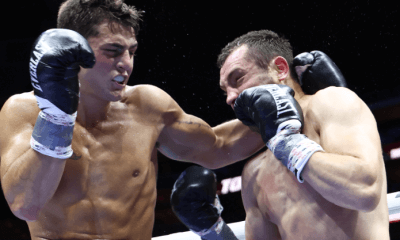
 Featured Articles2 weeks ago
Featured Articles2 weeks agoVito Mielnicki Jr Whitewashes Kamil Gardzielik Before the Home Folks in Newark
-
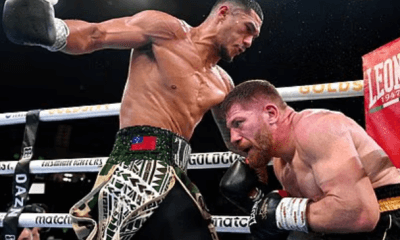
 Featured Articles4 weeks ago
Featured Articles4 weeks agoOpetaia and Nakatani Crush Overmatched Foes, Capping Off a Wild Boxing Weekend
-
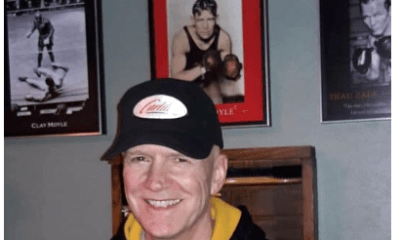
 Featured Articles3 weeks ago
Featured Articles3 weeks agoCatching Up with Clay Moyle Who Talks About His Massive Collection of Boxing Books
-

 Featured Articles4 weeks ago
Featured Articles4 weeks agoFabio Wardley Comes from Behind to KO Justis Huni
-
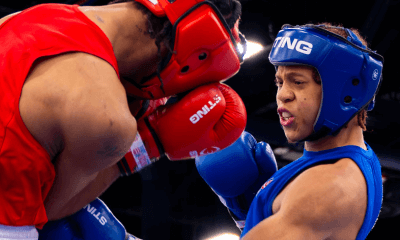
 Featured Articles2 weeks ago
Featured Articles2 weeks agoMore Medals for Hawaii’s Patricio Family at the USA Boxing Summer Festival
-

 Featured Articles3 weeks ago
Featured Articles3 weeks agoThe Shafting of Blair “The Flair” Cobbs, a Familiar Thread in the Cruelest Sport
-
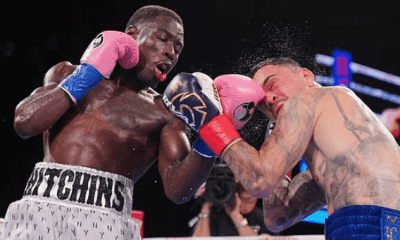
 Featured Articles3 weeks ago
Featured Articles3 weeks agoRichardson Hitchins Batters and Stops George Kambosos at Madison Square Garden
















